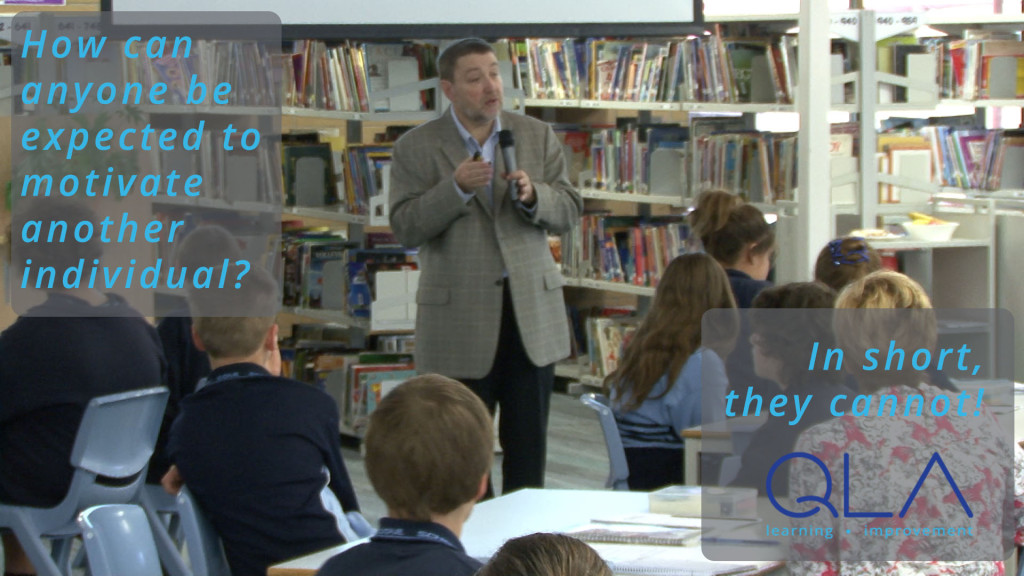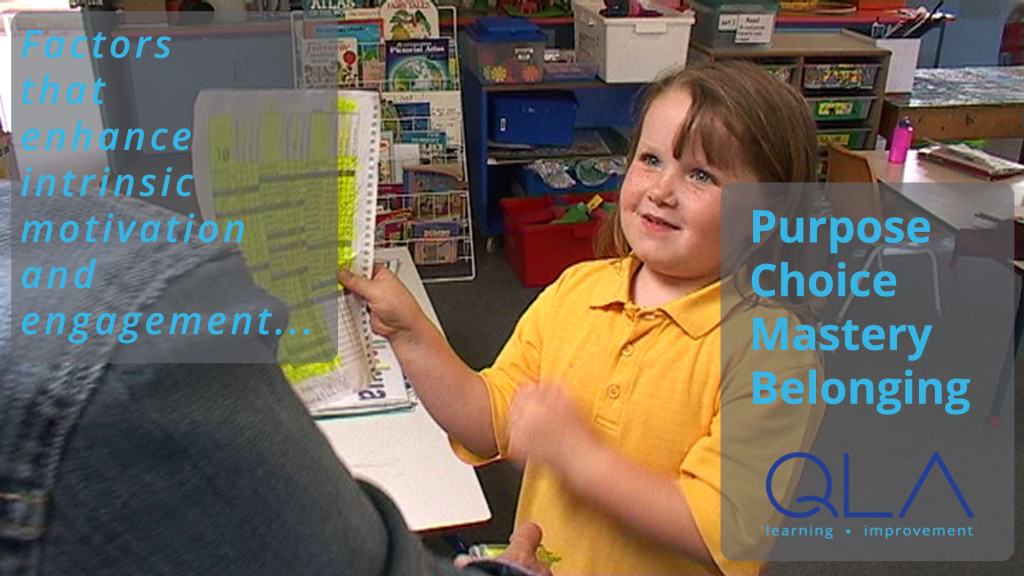This is the second of four blog posts to explore human motivation, and how we can enhance learners’ intrinsic motivation and engagement. These posts are edited extracts from our forthcoming book: Improving Learning: A how-to guide for school improvement.
In this post we discuss the personal nature of human motivation and introduce a framework of factors to enhance learners’ intrinsic motivation and engagement. We focus upon the first two key factors, namely purpose and choice, as keys to unlocking intrinsic motivation and engagement.
Motivation is personal
One of the biggest challenges in coming to understand human motivation is the highly personal nature of it. Something you may find compelling others find tedious. The factors that enhance my motivation can be very different to those that enhance yours. Factors that demotivate me may have little effect on you.
The rewards and threats of punishments needed to stimulate action vary enormously from person to person too. Factors that drive deep engagement also vary.
How can teachers be expected to motivate their students? How can principals be expected to motivate their teachers? How can anyone be expected to motivate another individual? In short, they cannot!

Despite this fact, most of us have been taught that a key aspect of a leader’s job is to motivate others. This is particularly true of teachers, which is unfortunate. While teachers can certainly inspire, support, encourage and mediate the learning of their students, they cannot motivate them. However, the systems and processes they put into place in their classrooms can de-motivate them.
High degrees of engagement and intrinsic motivation come from the drive within each individual. Yet, we continue to build extrinsic motivation factors, such as rewards and punishments, into the structure and operation of our systems. In doing this, we damage intrinsic motivation.
If it is not possible to compel others to become engaged, how can we maximise engagement and intrinsic motivation?
Teachers manage systems of learning. In order to maximise motivation and learning, teachers need to identify and remove the de-motivators: the barriers to learning, and create a systemic environment that maximises the factors that unlock intrinsic motivation and enhance learning.
Over the past decade we have drawn upon a wide range of research as well as our own experience to develop the following framework of factors that can enhance intrinsic motivation and engagement. This model draws on the work of Deming, Kohn, Herzberg, Langford, Scholtes, Senge, Pink and Hattie.
Factors that enhance intrinsic motivation and engagement
Purpose |
Meaning |
Advancing my interests and passions. Making a positive difference to me or others |
Relevance |
Pertinent to me, my situation and my future | |
Possibility |
Accepting what is to be accomplished and uncovering the potential of what could be achieved | |
Choice |
Responsibility |
Committing to the task. Experiencing a sense of authority. Being relied upon by others |
Autonomy |
Selecting methods and resources, defining quality standards and determining time-lines and milestones | |
Creativity |
Exploring and expressing thoughts, skills, imagination and individuality | |
Mastery |
Challenge |
Finding the task interesting, compelling and achievable |
Achievement |
Monitoring one’s own progress and performance. Celebrating learning and success | |
Learning |
Trying things, making mistakes, developing new skills and finding different ways of thinking | |
Belonging |
Collaboration |
Enjoying interdependence, working towards shared goals and experiencing authentic teamwork |
Feedback |
Giving and receiving constructive feedback and encouragement | |
Support |
Recognising skills and abilities in one’s self and others. Sharing, helping, learning together. Being free of fear |
Factors that enhance intrinsic motivation and engagement

The factors identified in this framework are generic in that they apply, to varying degrees, to everyone. It is a framework of common causes. By building these into our systems we tap into intrinsic motivation.
Let’s look more closely at the first two groups these factors…
Create purpose
Of the four groups of factors that can enhance motivation and engagement, purpose is perhaps the most personal. Purpose relates to the nature of the task. Things that abound with meaning, relevance and possibility for one person can be totally devoid of purpose for another.
Meaning
Activities that tap into an individual’s interests and passions result in greater drive than activities that do not. Most people are driven to do things that will make a positive difference for themselves and in their own lives. Most individuals also derive meaning from making a positive difference for others in the world. Finding a sense of meaning in a task or activity can be a strong motivator. Meaning inspires passion and commitment. Meaning unlocks intrinsic motivation.
Relevance
To be driven to action, that action needs to bear some relation to the life of the individual. Actions that accord to the circumstance and needs of the individual provide greater intrinsic motivation than those that do not. Lack of relevance is a de-motivator; ask any teenager (or teacher participant of a professional learning workshop!).
Possibility
Possibility relates to the extent to which an individual uncovers and ‘buys into’ a vision of what might be possible. As a first step, the potential of an activity must be clearly understood and accepted. What could be the benefit of this? What would it look like to do this superbly well? Failing to see the possibility in a task is usually de-motivating.
Collectively, these three factors – meaning, relevance and possibility – help the individual understand: what is to be done, why it should be done, how it relates to the individual and the individual’s future, what can be achieved, and how pursuit of the activity matters in the larger scheme of things.
Provide choice
These factors relate to the extent to which the individual has a sense of control over tasks. These factors consider the degree to which the task offers the opportunity to practice responsibility, enhance skills of self-management, and exercise creativity and self-expression. Not feeling in control leads to anxiety. Anxiety is a major barrier to intrinsic motivation and learning.
Responsibility
Being given the authority to get the job done and doing what it takes to do the job well is what responsibility is all about.
Following someone else’s directive is very different to accepting responsibility. Some managers complain that their employees don’t accept responsibility. Parents and teachers make the same complaint about children. Some principals complain about teachers. What they are frequently saying is that people will not do as they are told, rather than people are failing to exercise responsibility!
Being afforded the authority to engage with a whole task, not just bit of it, and developing a sense of being needed by others can enhance motivation. Not being given the authority necessary to take responsibility is de-motivating.
Autonomy
While responsibility is about accepting one’s role in the completion of an activity, autonomy is about exercising choice regarding the activity itself and in how the activity is handled.
To act autonomously is to make choices about the activities, methods and resources to be used, which include establishing a schedule and then self-managing that schedule. To act autonomously is also to participate in defining the quality standards – the criteria by which the quality of the activity will be measured.
With autonomy comes a sense of control. Exercising autonomy can unlock intrinsic motivation.
Creativity
Creativity goes beyond taking on a task and choosing how it will be managed, into the realm of individual expression. The freedom to explore one’s own imagination, thoughts and skills in applying them to a task can be highly motivating.
Mastery and Belonging
In subsequent blog posts, we will expand upon the remaining two groups of factors – Mastery and Belonging – and contrast the use of reward in classrooms with identifying and removing barriers to learning and improvement.
Until then, we encourage you to discuss these ideas with your colleagues. If you are a teacher, you may wish to explore these concepts with your students. If you are really game, you may like to ask your students (and colleagues) the degree to which these factors are evident within your systems of learning. Furthermore, you could seek suggestions regarding improvements to the systems of learning to enhance motivation and engagement.
If you have observations, suggestions or questions, please share your comments!

One thought on “Human Motivation 2: Purpose and Choice”